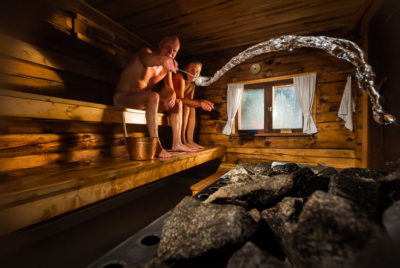Infrared Sauna Temperature Considerations

The benefits of saunas have been known for thousands of years. The earliest civilizations used steam rooms to draw sweat from the body to remove impurities or to simply relax. Traditional saunas evolved, however, to include more technology by way of infrared light. Some appeal of modern technology is largely based on infrared sauna temperature which is far more tolerable than early steam rooms.
Why is Infrared Sauna Temperature Important?
Early saunas known as traditional saunas use heat differently than an infrared sauna. Traditional sauna designs consist of wooden enclosures that deliver dry heat along with low humidity. Heat temperatures in a traditional sauna may reach as high as 195 degrees Fahrenheit. In many cases, the level of heat is uncomfortable for some people to handle which means that they will ultimately spend less time inside of the sauna.
The temperature of a sauna is important because it is heat that generates sweat in the body. The process of sweating aids in detoxifying the body, soothing stress, improving the skin, burning calories and stimulating the cardiovascular system. Research suggests that saunas are an effective treatment for pain relief, muscle soreness, and stiff joints. Some people simply do not tolerate the high heat of traditional saunas well which means that it may take more sessions at shorter rates of time to achieve the maximum benefits of heat therapy.
Suggested IR Temperature Range
Infrared sauna temperature, on the other hand, is frequently more tolerable than traditional saunas. Studies indicate that an infrared sauna should be set between 110 degrees and 130 degrees Fahrenheit. There are a couple of factors that play a role in how quickly a sauna heats such as its size and the temperature of the surrounding environment. Every sauna is designed differently and the time it takes to reach an ideal temperature may vary.
Another difference between infrared sauna temperature and traditional sauna temperature may be found in the concept of radiant heat. Infrared saunas use radiant heat refers to the heat that you cannot see but rather can feel. Radiant heat directly targets the body as it is absorbed into the skin cells. Traditional saunas raise the temperature of the surrounding atmosphere and therefore do not heat the body directly. The body is made to absorb infrared waves and as a result, the waves are accepted into the deep layers of the skin’s tissue.
Due to the fact that individuals can enter an infrared sauna at a lower heat setting, people can enjoy longer sessions. In fact, experts recommend entering a sauna before it reaches its maximum setting as a way to achieve the most benefits. Research suggests that the most ideal infrared sauna temperature is 130 degrees Farenheight and in some cases 140 degrees Fahrenheit. Many users enter an infrared sauna when it is around 110 degrees Fahrenheit or slightly higher.
Lower Temperature vs Higher Temperature
Infrared sauna temperature may be used to focus therapy on specific areas of concern. In certain scenarios, a lower temperature may deliver more targeted benefits than a higher temperature depending on what part of the body is being treated. The temperature has a direct effect on not only how sweat is produced but how much sweat is produced and from where. The temperature and length of time spent under a specific temperature will determine what sweat glands go to work and the volume at which they excrete materials from the body.
Although the body must release sweat in order to remove toxins, it should not become dehydrated. Higher temperatures as found in steam saunas may lead to a rapid loss of fluids and possible dehydration. Infrared sauna temperature, because it does not need to reach excessive levels, is a safer alternative that allows people to sweat at a lower temperature. As a result, fewer fluids are lost and more electrolytes are retained. There is a relationship between a low infrared sauna temperature and increased release of toxins versus a high steam sauna temperature and a decreased release of toxins.
Infrared saunas are proven to be effective in removing impurities from the body. Although traditional saunas are the basis of the most modern designs, they are not as effective at treating some conditions due to the high level of heat that is emitted from the systems. Infrared waves penetrate the skin for a longer time and at a lower heat setting.
Due to the process of heating involved in an infrared sauna, individuals can enter a unit at a low heat setting, begin sweating before it reaches maximum temperature, and spend a long time in a system without feeling uncomfortable. The longer a person is able to tolerate the temperature of an infrared sauna, the more health benefits they are able to achieve. Moreover, heat levels play an important role in maintaining the body’s function while undergoing treatments.



